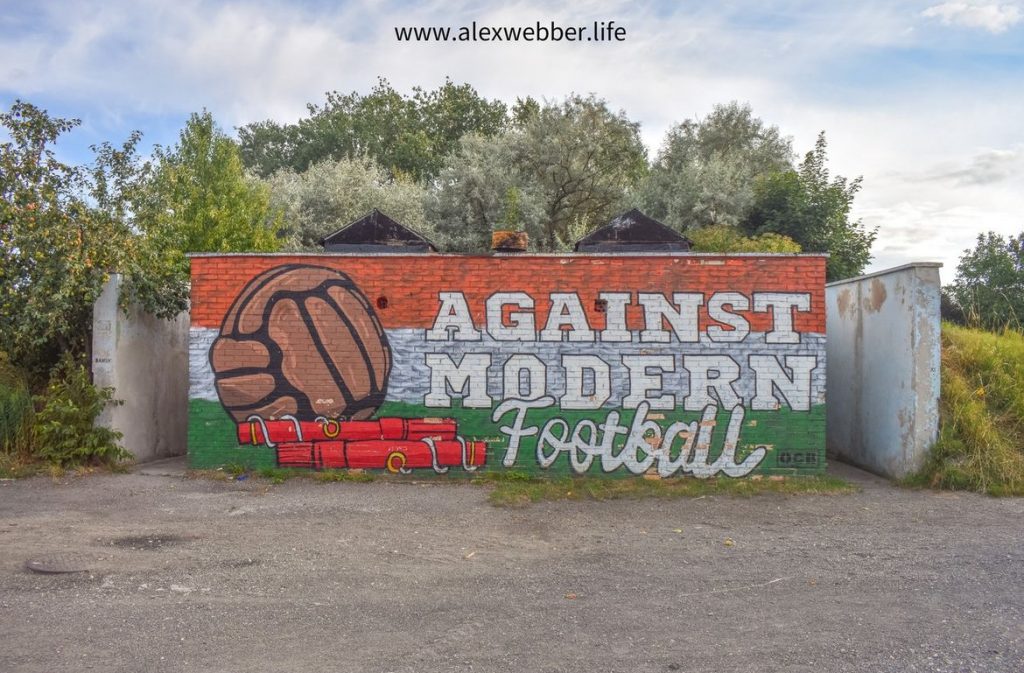The Iron Curtain, tigers, storm chasing, undercover police, flag burning, and a ruptured ACL. Welcome to the wonderful world of photographer, Alex Webber who slaps you off the face with a Kielbasa, and submerges you into the magnificent growling underbelly of Polish football culture.
Alex invites us into the beating heart of Polish football, where it pounds furiously with chaos, characters, fist-fighting and fire….so much fire. He navigates the labyrinth of leagues and ladders watching everybody from Legia Warsaw to Motor Lublin, uncovering the furthest corners of Polish football, where he’s been pelted with seats and rocks, arrested, soaked with piss, spat on, mistaken for undercover police, and kicked, punched and chased. He’s even witnessed a flip-flop being wielded with deadly intent.
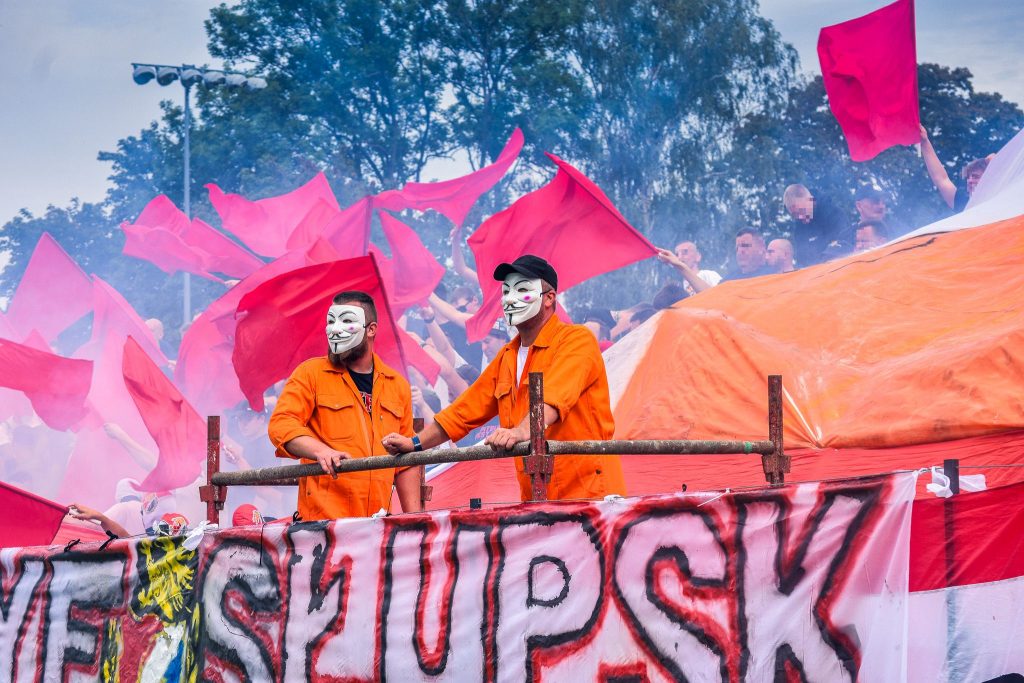
It’s a journey that began in Bristol and took him beyond the Iron Curtain, into Vilinuis and onto Warsaw. A place that he now calls home. “Warsaw is unrecognisable now, a modern, dynamic metropolis whose potential and ambition have no limit,” Alex explains. “Back then though, it was raw and uncensored. It was a grim city but as a young foreigner, it was electrifying.”
Since those halcyon days, Alex has covered over 150 stadiums across Poland, bringing life to each and every single one, many of which stand as living archives of the nation’s footballing legacy. “A photo can be technically poor, but if it captures the atmosphere of a place or a person’s character, then you’ve won already.”
Alex is self-effacing and modest when it comes to his work, describing his technique as very much, ‘Spray and pray.’ This, of course, does him a great disservice and doesn’t tell the whole story of his photography, which takes you into the eye of the storm. Like a midfield general, he is involved in the thick of it all, capturing every piece of action taking place on and off the pitch. In a time when there is such disparity between football and its fans, his work has a beautiful way of reminding you how football can connect with people.

It was Italia 90 that first seduced Alex and marked the beginning of an obsession with the game that would then take him to Ashton Gate where he would fall helplessly in love. “It wasn’t so much the football, but everything else around it. It was like being swallowed whole by a tsunami. It was intoxicating: the noise, the energy, the smells, and the sights, all presented in a fantastic kaleidoscope of sensations. And yeah, an awakening of the senses is what I can best describe it as.”
However, as football began to whore itself out to the corporate cocks who would impregnate it with vanity, devouring all of its personality and abandoning the principles on which the game was built, Alex found his love for the game slipping away. “I think it’s now widely accepted that the 90s was ‘the last great decade’ before domestic football became a Sky product.”
It would take the good, the bad, the mad and the mundane and downright weird eccentricities of Polish football to resuscitate his broken heart, and make him fall for the game all over again. It was a reawakening: his football second life and it would catapult him across the country where he would experience everything from pyros and punch-ups to pitch invasions.

At this moment in time, Polish football stands on the precipice of change, just as English football once did. Poland doesn’t do prawn sandwiches, not yet anyway, and Alex wants to drink in every last drop of nostalgia before modern stadiums replace the relics of yesterday forever. There is real historical and social value in capturing and recording these changes as they occur in real-time and as Poland continues to evolve on the footballing stage, these stadiums remain timeless symbols, linking the past, present, and future of the beautiful game.
“Polish football is at a distinct fork in the road – the old stadiums are disappearing and being replaced by grounds that looked like they were ordered from a catalogue. As an experience, the top-flight has already had its edge bevelled off and I’m in a race against time to experience all that I want further down the league ladder. The seismic off-field changes that are happening have pushed me even further – I feel a need to document these changing times.
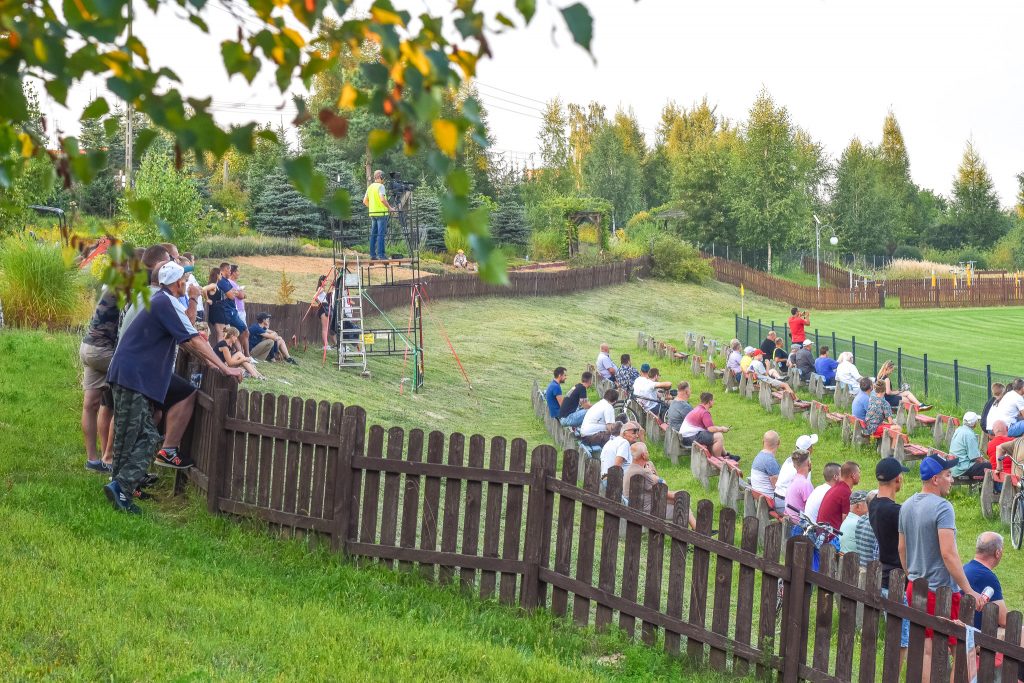
We’ve seen specifically how modernised English football has become, and the money which has been pumped into clubs like Manchester City has resulted in the rise of ‘football tourism.’ As a result the atmosphere at the Etihad often resembles a picnic on a sedate sunny afternoon during a heatwave. Not even a frenzied Pep Guardiola roaming the touchlines like a madman can get a rise from the crowd. Fans will simply sit on their padded seats, waiting to be entertained, and clap politely when their team obliges, as they sip on their frappuccinos. If one day Polish football is to succumb to modernisation and Lego stadiums, it can only be hoped that it doesn’t kill the culture within that makes football here so unique.
Like a footballing David Attenborough, Alex spends hours each week planning trips: swapping tip-offs with other photographers or digging through fixture lists to explore the Ekstraklasa and beyond. Indeed some of his most memorable experiences have come from investigating the depths of the lower leagues. “Initially, I was just visiting the big clubs in the big cities, you know, combining a weekend away with football. It didn’t take long though to start getting a little more experimental. A fast-track self-education on the Polish game and fan culture allowed me to broaden my scope, to target the more lively lower league games – the stranger stadiums, the under-the-radar bangers.

“I want to peer into the furthest corners that Polish football offers: I want to see everything, and I really hope that is demonstrated by the variety of my output. There are so many fascinating sub-plots and stories to Polish football that the narrative should not be reduced to being solely about its more boisterous side.”
When I see talk of a European Super League, and read about plans for a World Cup being staged every two years, a thick taste of disgust foams from my mouth. When football continues to become more about wealth and power than the people, it leaves me feeling numb. The game that I grew up loving has never felt farther away from what it once was.
For a moment though, when you witness the work of Alex Webber and listen to him talk of his adventures across Poland, it reminds you of the game you once knew and you begin to realise that it is still alive. It hasn’t been taken from us yet.
It was a genuine privilege to sit down with Alex as we spoke about his early hair-raising days in Warsaw, how he got into photography, his experiences across Poland and what it’s like to be confronted by fans in a vodka-amphetamine psychosis.

fucking hell, you don’t get this back in Bristol. I was hooked from the off.
After hitting a bit of a dead end in my early 20s, an interrail trip around Europe saw me speculatively send my CV to a city guide magazine covering a string of cities behind the former Iron Curtain. I guess, in those days, anyone could land a job in that part of the world if they got creative with their resume, and so it was that I managed to wangle a job.
After starting in Vilnius, Lithuania, I was swiftly shipped off to Warsaw, a position no one else in the firm wanted. Warsaw was never part of a grand plan, I basically ended up there because I had no choice.
Back then, it was a dark, nasty-looking city but one with an underlying Factor X: a hybrid of Gotham and the squalid Times Square depicted in Taxi Driver. Being a young expat arrival, of course, I bloody loved that.
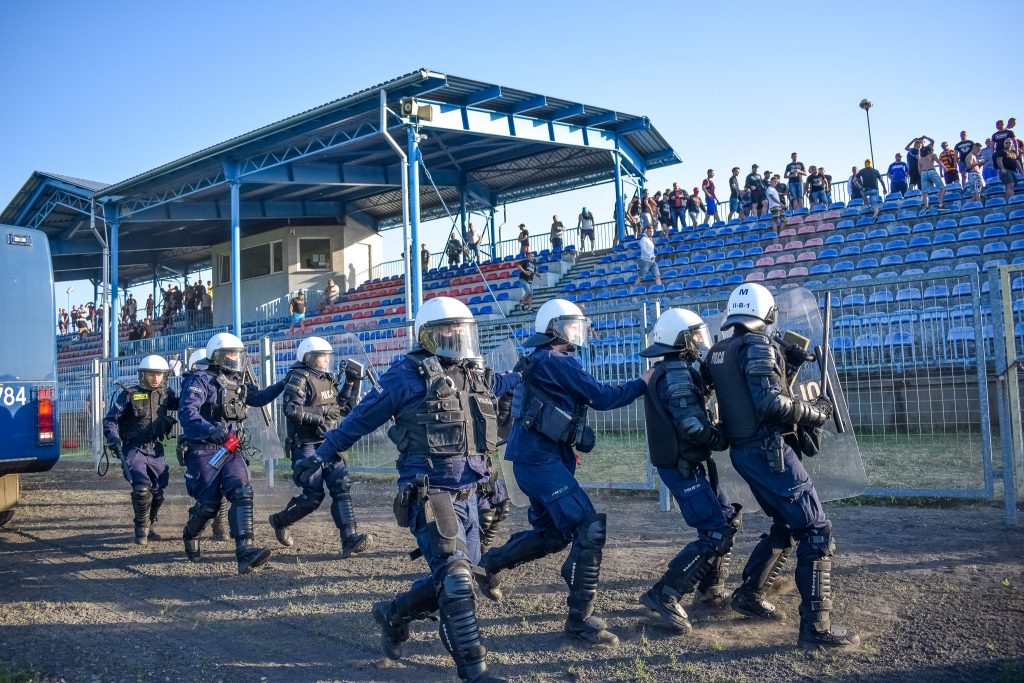
From the moment I got to Warsaw, every day was a wild adventure. Christ, on my first day two tigers escaped from a zoo and were terrorising a suburb. I watched the drama unfold in real-time, staring at the news reports playing out on TV from the safety of my hotel room. It took police marksmen a while to turn up so local shopkeepers took up the chase with broomsticks. When marksmen did finally arrive, they missed their shot and killed a vet who was on the scene instead. Tragic as this was, I remember thinking, “fucking hell, you don’t get this back in Bristol”. I was hooked from the off.
Warsaw is unrecognisable now, a modern, dynamic metropolis whose potential and ambition have no limit. Back then though, it was raw and uncensored. It was a grim city but as a young foreigner, it was electrifying.
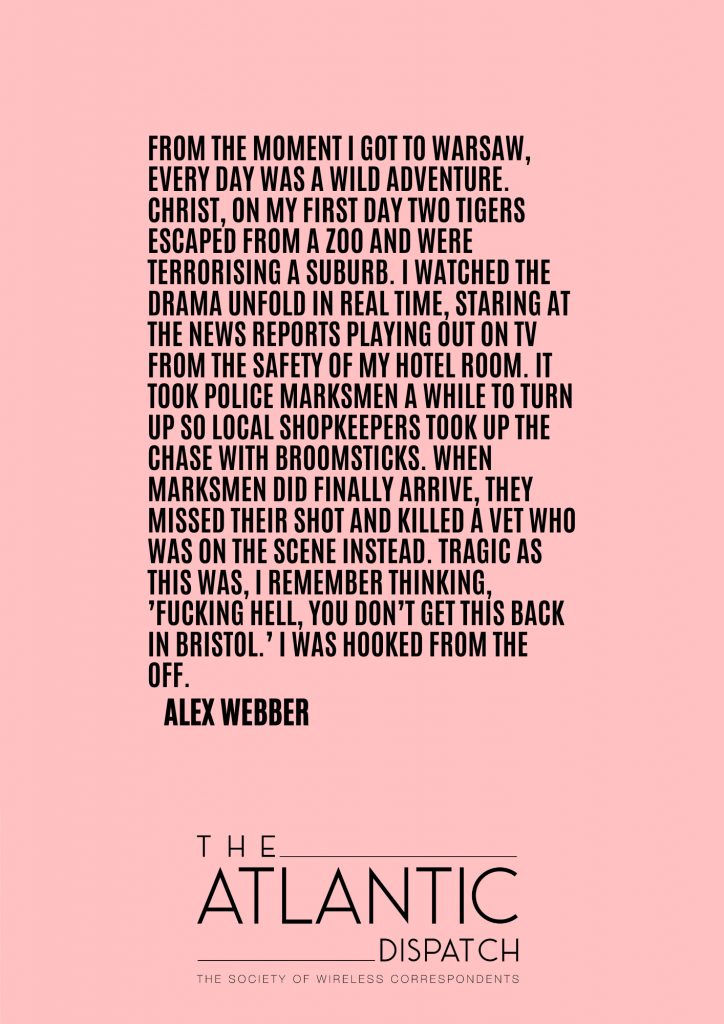
the latter-day experience is a pale shadow compared to the one I fell in love with.
Italia 90 is where it all started for me. Football hadn’t interested me before, not remotely. But something about Italia 90 lit a spark within. I was 13 at the time, an impressionable age, and just became absolutely obsessed with the tournament for reasons I have never been able to fathom. I devoured everything to do with it.
It was natural that when the tournament ended, I looked to continue this newborn football affair with my local side, Bristol City. It was love at first sight. I guess it helped that my first game was a helter-skelter 4-2 thriller, but it wasn’t so much the football, but everything else around it. It was like being swallowed whole by a tsunami. It was intoxicating: the noise, the energy, the smells, and the sights, all presented in a fantastic kaleidoscope of sensations. And yeah, an awakening of the senses is what I can best describe it as.
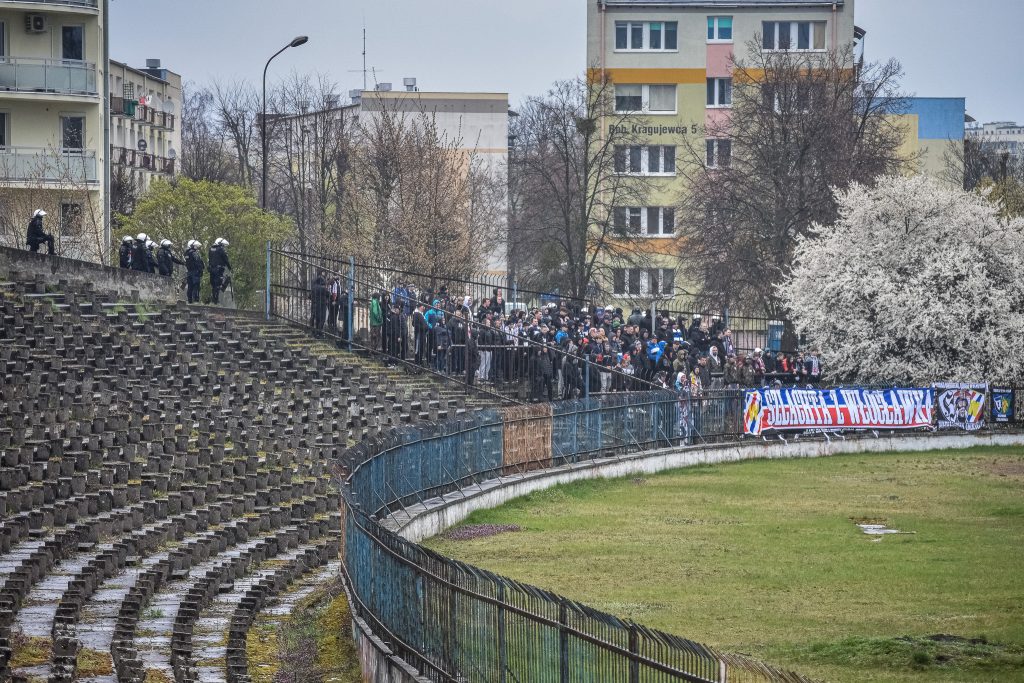
I remember as we got a little older, me and my friends would lament that we had been born a decade too late, that we had missed football’s finest hours. Now, in hindsight, I realise how lucky we were to catch the tail end of the terraces, of the old grounds and the old-school atmosphere. I think it’s now widely accepted that the 90s was ‘the last great decade’ before domestic football became a Sky product, and I’m fortunate that I enjoyed this last hurrah to the max.
Nowadays, the English game holds next to no interest at all – only rarely will I tune in to a game on TV. I don’t have a scooby who the players are, and I’d honestly struggle to tell which club plays in what league. Of course, when I’m home, a visit to Ashton Gate is mandatory, but the latter-day experience is a pale shadow compared to the one I fell in love with.
If my first Bristol City match had been my awakening, Lublin was a reawakening: my football second life.
I first picked up a camera about seven years ago – I’d just got my first dog and basically wanted to take proper pictures of her growing up! The football photography was a complete and utter accident of circumstance. I had a work trip booked to the eastern city of Lublin, and I remember that it got canned at the last moment. Seeing as I’d paid for my hotel, I went along anyway.
I Love the city, one of my favourites in Poland, but after a few days, there wasn’t a pub left for me to visit. In desperation, I called the local club and asked if I could have a look around the ground – they were clearly as bored as I was because they answered yes and sent their press guy to guide me around. I was met with such sincere hospitality I was staggered. Leaving, the guy made me promise to visit for a match once the winter break ended and I delivered on that promise a few weeks later.
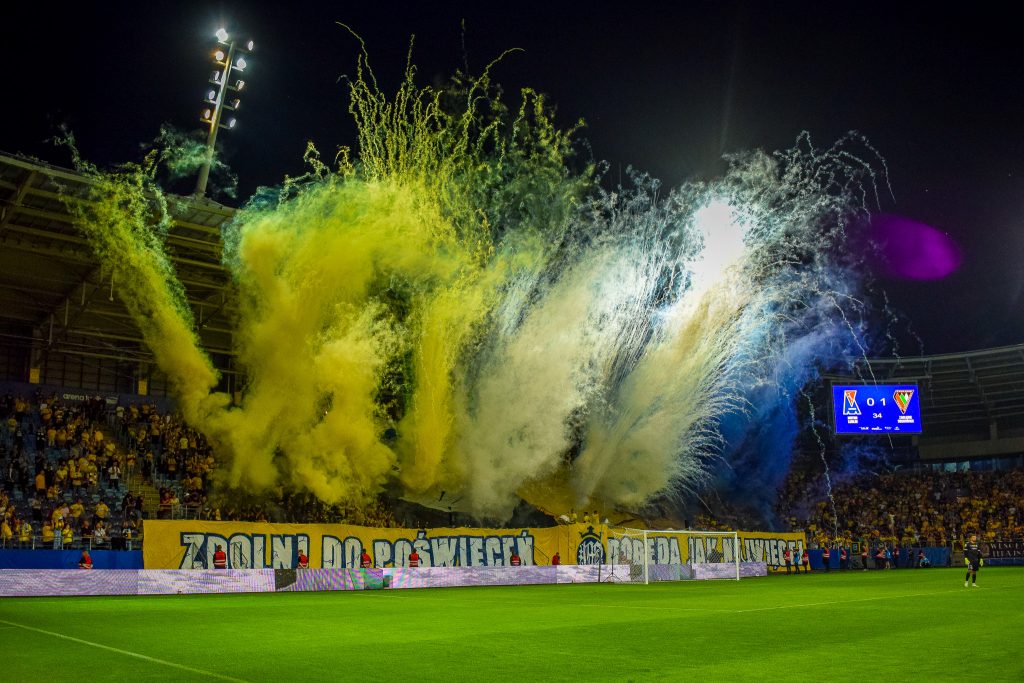
I went as a fan that match, paying about 20 quid for a VIP ticket that scored me as much as I could drink and the best seats in the house. The crowd was dismal, but the ultras behind the goal never stopped the singing. I had taken along my camera for reasons unknown, and recall just having a great time shooting random pictures of everything that happened before me. It all just snowballed from there – and not just the photography.
Prior to that, my experiences with Polish football had been calamitous. I’d done a few games in my early years here, yet luck had not been on my side. All the games seemed to coincide with a fan boycott or such – only no one ever told me. I’d leave thinking, bloody hell, there’s more life on Mars. After this game, however, I couldn’t wait to get back to football. If my first Bristol City match had been my awakening, Lublin was a reawakening: my football second life.
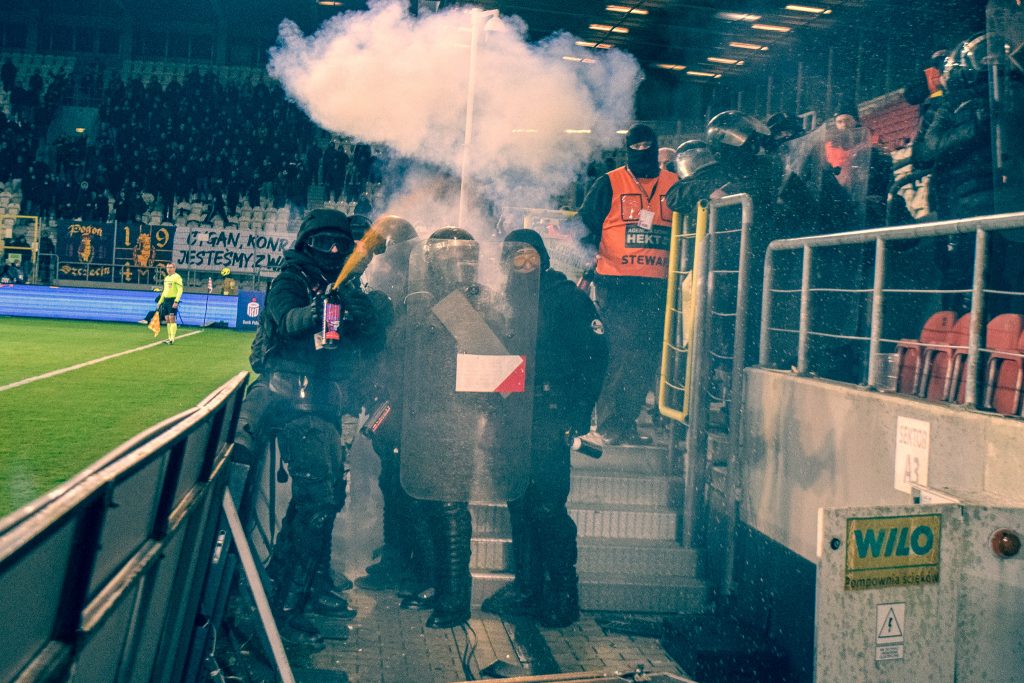
the good, the bad, the mad and the mundane. Most of all – the downright weird.
You know what, I’m not sure I have a style – what I simply try and do is show the world as I see it. Whether I’m successful in doing so is down to others to judge, but what I seek to do is get under the skin to show a texture to football: the good, the bad, the mad and the mundane. Most of all – the downright weird. The football experience is multi-dimensional, I hope I capture a little bit of its eccentric character.
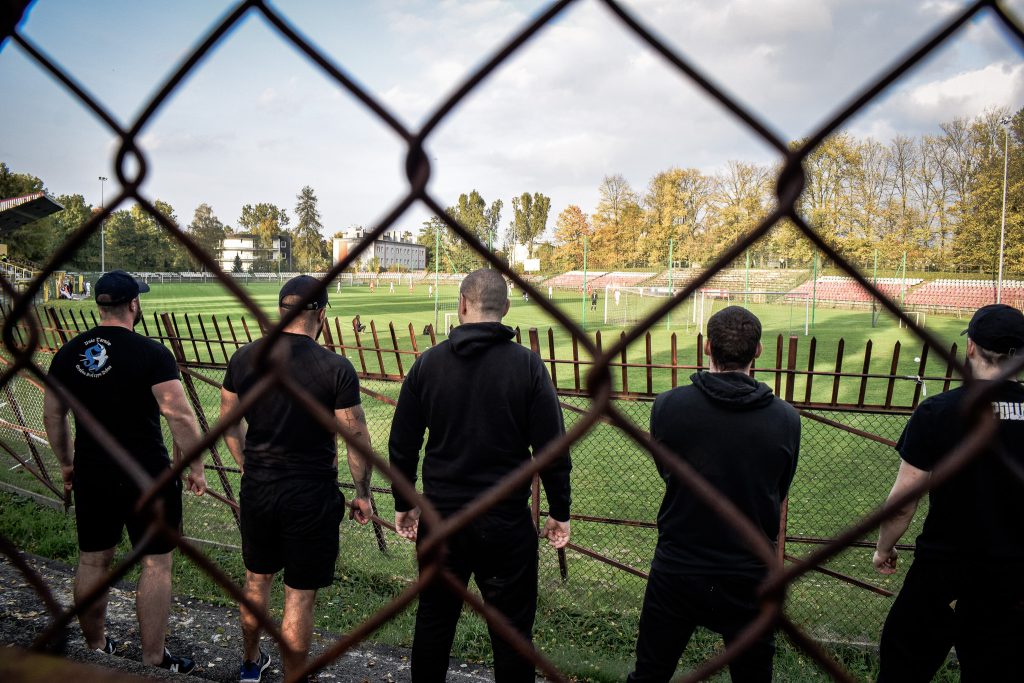
Is there anyone I look up to? On the football front, three stadium photographers really stand out: Mike Bayly, Dave Harry and Leon Gladwell. All three specialise in hunting down unique, beautiful grounds that belong in football heaven, but whilst they share the same detail-driven approach, all three have a slightly different style. I could stare for hours at their pictures, and I think I sometimes have!
Outside of football, my good friend Ed Wight, a Poland-based reporter and photographer, has been very influential. Way before I even had a camera I’d often accompany him on assignments. Tagging along with him on some shoots, I watched how he interacted with people and saw how important it was to establish rapport or to throw yourself into the vibe of a scene. A photo can be technically poor, but if it captures the atmosphere of a place or the character of a person then you’ve won already.

It’s a numbers game – I shoot anything from 1,000 to 1,500 pictures each game, and if I’m lucky around one in ten will be ‘usable’. Spray and pray! There is no such thing as taking too many photos, and the best teacher is experience. Soon you’ll learn what works and what doesn’t.
I must add though, I feel like an imposter at times. I do not count myself as a photographer. I use two entry-level Nikon cameras that do the job. But let’s not kid about, I am utterly out of my league at the big games that have legit press snappers. You’ll see these professionals stalking the touchline with cameras bigger than the Hubble fucking telescope, and then there’s me, bumbling around after a few pints looking for a spot to have a crafty fag.
When it comes to technique, theory or basic mechanics, I can tell you just about nothing about photography! Given that, the feedback I receive has been astonishing. It’s heart-warming when people say nice things but I still get the idea I’m getting away with it a bit.
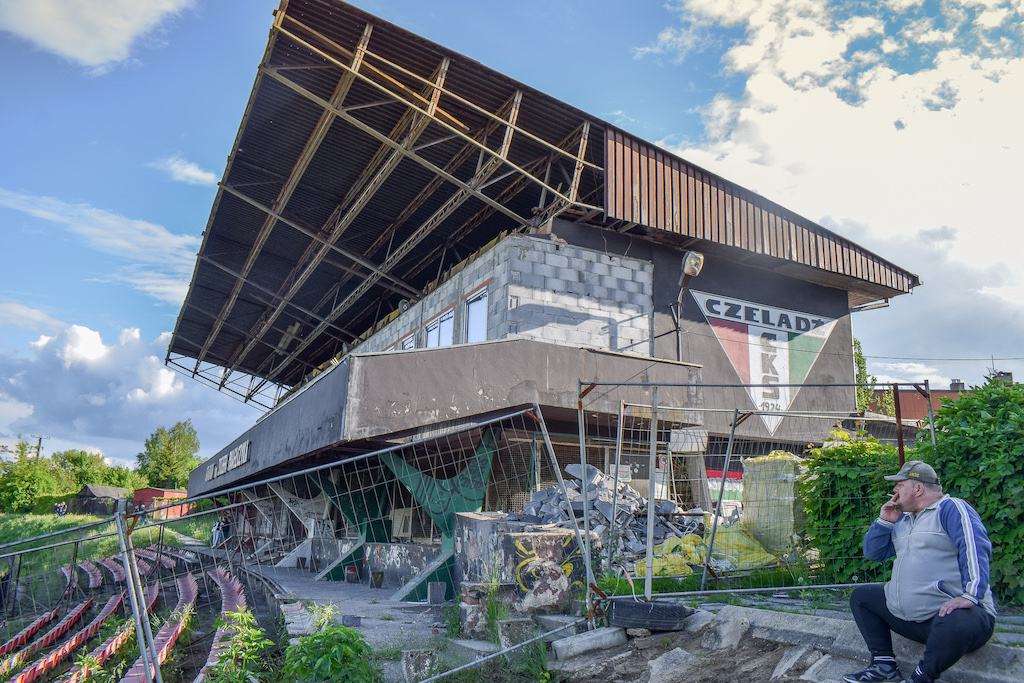
I started gravitating more towards what I call ‘storm chasing.’
Straight after that Motor Lublin game in 2016. The football bug was back – with a vengeance. There was much time to make up! Initially, I was just visiting the big clubs in the big cities, you know, combining a weekend away with football. It didn’t take long though to start getting a little more experimental. A fast-track self-education on the Polish game and fan culture allowed me to broaden my scope, to target the more lively lower league games – the stranger stadiums, the under-the-radar bangers.
About five years or so ago I became accredited as a photographer with a very high-profile Ultra website in Poland and that’s when things really took up a gear or two. It was then that my focus shifted to tracking down the more high-risk games in the lower leagues, and it was then I started gravitating more towards what I call ‘storm chasing’. There’s a small core of photographers who dedicate themselves to this pursuit of mad Polish matches, and they’re a brilliant and diverse bunch.

Finding these games does not come easy. I spend hours each week planning trips: swapping tip-offs with other photographers, or digging through fixture lists that are Byzantine in complexity before matching them up with equally confounding transport schedules, booking sites, etc. And then often having to start from scratch after learning of a last-minute stadium closure or an away travel ban, etc.
The police wield extraordinary power in Poland, and it’s not uncommon to travel the length of the country to find, with kick-off minutes away, that away fans aren’t being let in. The frustrations and letdowns are part of the game.
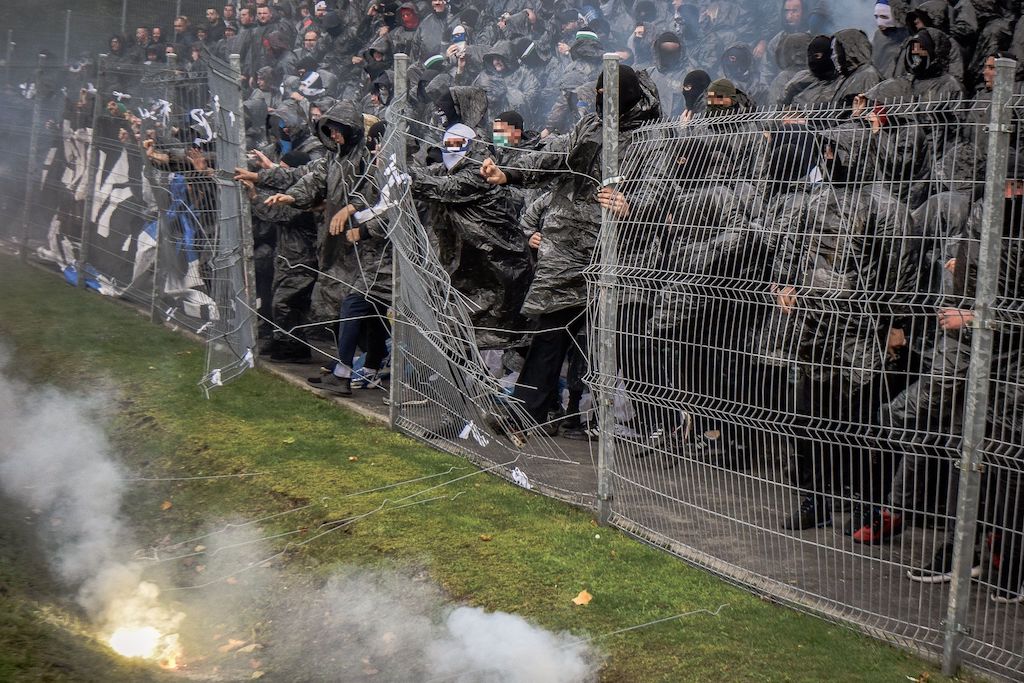
I firmly believe that one day, my images of Poland in this time of change are going to carry an almost social value – at least to a handful of weirdoes!
I would compare it directly to the 90s in England in that Polish football stands at a distinct fork in the road – the old stadiums are disappearing and being replaced by grounds that looked like they were ordered from a catalogue. The fan scene, also, is being hammered by various draconian measures introduced by the authorities. I have no doubt that Polish football will be a completely different creature in five years, if not before.
As an experience, the top-flight has already had its edge bevelled off and I’m in a race against time to experience all that I want further down the league ladder.
The seismic off-field changes that are happening have pushed me even further – I feel a need to document these changing times. The 90s were a magical chapter for English football, but I was left with nothing but splintered murky memories. I want to have something more this time around. Moreover, as conceited as it might sound, I firmly believe that one day, my images of Poland in this time of change are going to carry an almost social value – at least to a handful of weirdoes!

Negative as this assessment is of Poland’s direction, those who visit from abroad are going to be richly rewarded. The ultra culture is dimming under the focused spotlight of the authorities, but the atmosphere is so many levels above what we have in England that it belies belief. That said, I can’t stress enough, that you need to do your homework first to find the right fixture.
During that period of paranoia, I often looked back to that final match and it took on a warm, sentimental meaning during those unreal days of the apocalypse.
So many games, and so many brilliant memories. Igloopol Debica versus Polonia Przemysl is the one I want to really re-live the most, however. Early March, 2020. This game was a real storm-chasing gamble and, the outside odds of this being interesting were reflected by the fact that I was just about the only photographer present for this fifth-tier game. Attracting a crowd of around 400, it was one of those long shots that broke into mayhem.
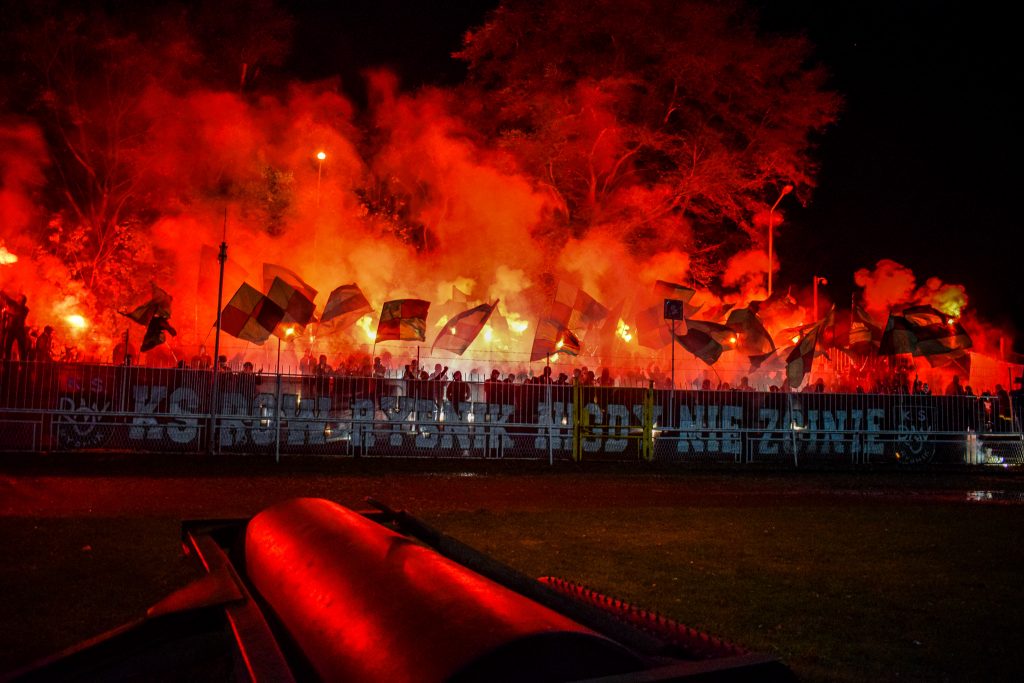
But beyond the ensuing tear gas, pyro, punch-ups and pitch invasions, the sight that lives the longest was a candidate for Poland’s biggest gorilla embarking on his own private war with the police force. All this taking place in a glorious throwback ground encased by broken terracing. It can be draining to maintain composure when it goes bananas, so for me the post-match beers are a wonderful ritual that plays an essential part that allows you to gently step off the madman’s express that you’ve been riding on earlier.
In this case, post-match beers happened when I got back to my base for that weekend, Krakow, inside a foggy bar that evoked the spirit of the city. A great night that followed a roller-coaster day. Of course, just days later Poland was in lockdown. During that period of paranoia, I often looked back to that final match and it took on a warm, sentimental meaning during those unreal days of the apocalypse.
In all truth, there was nothing that made this game anything more memorable than any other million, but I pick this over others because, through my own complete idiocy, I conspired to delete every single picture of this day a few months down the line. It lives only in memory. So yeah, I’d relive that day and make sure I backed up my snaps three times over!
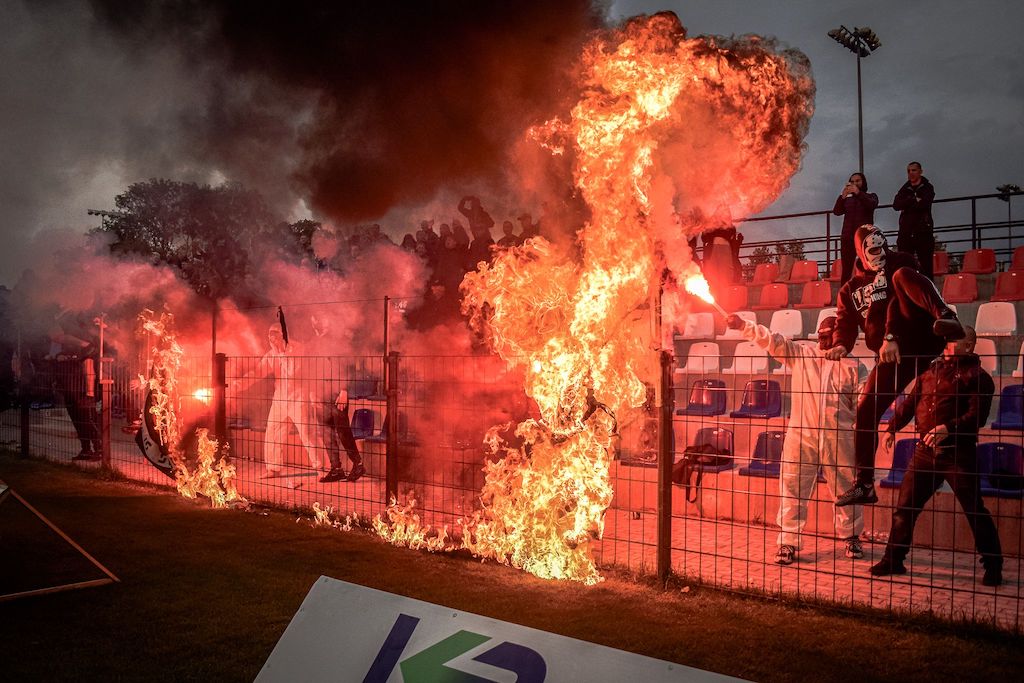
I thought I was getting my head stoved in that night.
I actively seek out the spicier games, so I’ve only myself to blame if it gets a little too heated. To complain would be like ordering a vindaloo and then whining to the waiter that it’s too hot to handle – and we’ve all got a friend who does exactly that! So no: if anything goes wrong, then it’s on me and no one else.
Generally, I’m quite confident in a stadium – at smaller matches where you’re instantly spotted shooting pictures, I’ll try and explain from the outset what I’m doing and why, that identities will be protected, etc.

Most often, people respond positively. And besides, in a stadium situation, you know that there’s an element of security. Perhaps the one situation that rattled me was over the summer when I was recognised hours after a match whilst walking back late to my hotel. The group that approached me was deep in that glazed stage of vodka-amphetamine psychosis and were absolutely convinced that I was undercover police.
The situation was ludicrous, yet everything I said seemed to agitate them further. Pressed up in a dark alley, with nowhere to run, it got very uncomfortable. I mean how crazy, they just wouldn’t believe I was English and were certain I was only pretending to speak bad, broken Polish. The situation just kept spiralling. I was frisked and only after they matched my ID to my Facebook profile were they finally satisfied. I thought I was getting my head stoved in that night.
It’s the first time I’ve ever seen a flip-flop wielded with deadly intent.
I did my ACL during a very lively encounter that took place between two sets of fans behind a stadium. Every possible implement at hand was being used – planks, bricks, wheelbarrows, garden rakes. It’s the first time I’ve ever seen a flip-flop wielded with deadly intent. I took dynamite pictures, I think the best I’ve ever taken, but they were waaaay too incriminating to ever be published. That’s what I really regret!
I really must hasten to add, I do not seek to glorify hooliganism. There are some utter psychopaths involved in the football scene here, and it is far more intense than anything we have had in the UK. It’s a very serious 24/7 lifestyle; it’s not a game. It’s not about dressing up in fancy clobber on Saturday and then having a laugh and beer with the lads.

However, life isn’t black and white, and while I don’t condone many of the actions, I’m not going to condemn them. Ultimately, we’ll learn more by humanising things we don’t understand rather than demonising them. I document what I see, and yes, on occasions that does mean the more hairy side of football, but it’s not my place to pass judgement.
It does need to be underlined, as well, that Polish football is fundamentally very safe. If you find yourself in the middle of any trouble you’ve either been incredibly unlucky or incredibly stupid – or, in my case, plain nosey. Polish fans deservedly have a fearsome reputation, but even the most volatile has no interest in the regular passing football tourist: most will actually respond with great hospitality and the majority of people I meet have been absolute diamonds.
There are so many fascinating sub-plots and stories to Polish football.
There are loads of differences between the English game and Poland. Sure, the newer stadiums will have a club bar that gets busy on matchday, but you’re not going to find that same buzz where pubs for miles around are packed to the rafters. I’m not kidding, I’ve been to games where I’ve been certain I’ve had more to drink than the rest of the stadium put together!
It’s a bit of a sweeping statement to make, so people can pick it apart, but I get the sense that the football is almost secondary to many – the ultras anyway are there to support the club, not watch the football if that makes sense. They have no qualms about spending the game underneath a banner, so long as they’re making a racket. And on this point, it’s worth dwelling. Crowds are poor compared to England, and only a clutch of clubs pull more than 15,000. But don’t think that translates to mean a poor atmosphere. I’ve always said that one Pole has the lungs of ten Brits. You need to multiply a Polish crowd to the power of ten to get a gauge of the ‘real feel’. Pick the right game – and again I have to stress how important that is – and you’re going to worry your ears will fall off. The stadiums can feel like volcanoes at times.

There are so many things to consider though in Poland, not least the complex cat’s cradle of alliances/pacts/friendships/rivalries that ultra groups keep with other teams. Imagine for instance if Newcastle had a pact with Bristol City who in turn might have a pact with say Wrexham. That would mean if Newcastle played Bristol Rovers, for example, then there’d be City at the match in the Newcastle sector along with Wrexham – and then Rovers would have all their mates along as well. It’s so complicated it can drive you around the bend getting your head around it, and it makes trolling the fixture lists even trickier as you have to keep in mind all of these factors. It’s genuinely not unusual to go to a match where you have groups of fans from around ten different clubs.
And then there’s the topic of flags and colours – these are sacred. A couple of years back, Lech Poznan were barred from bringing their banners into a cup final, as a result not a single one of their fans entered the stadium – thirty thousand hanging around outside in the car park. Imagine that kind of demonstration of fan power in England. The FA would soon change their tune if the Cup Final was played in an empty Wembley. If we want things to change in English football, we need to show some balls rather than singing Sack The Board or writing an angry letter to When Saturday Comes.
As much as I hunt the bangers though, life is all about balance and I love nothing more than doing something lively one day and then a snoozy, sedate match in a picturesque setting the following afternoon. Polish football should not be framed around the ultra movement, even though it plays a big, conspicuous part. It needs to be viewed deeper than that. Again, it’s about finding texture. I want to peer into the furthest corners that Polish football offers: I want to see everything, and I really hope that is demonstrated by the variety of my output. There are so many fascinating sub-plots and stories to Polish football that the narrative should not be reduced to being solely about its more boisterous side.

Czuwaj Przemysl in the south-eastern provincial leagues should be considered the ultimate grail.
Most of the old grounds in the top couple of tiers have gone or are in the process of going. Anywhere old school ticks my boxes and even more so if the club is in a brilliant city: Stomil Olszytn for instance has that, GKS Katowice, Odra Opole – grounds with real character in cities that are vastly enjoyable for differing reasons. Unfortunately, stadium moves for the latter two will happen at the end of the season.
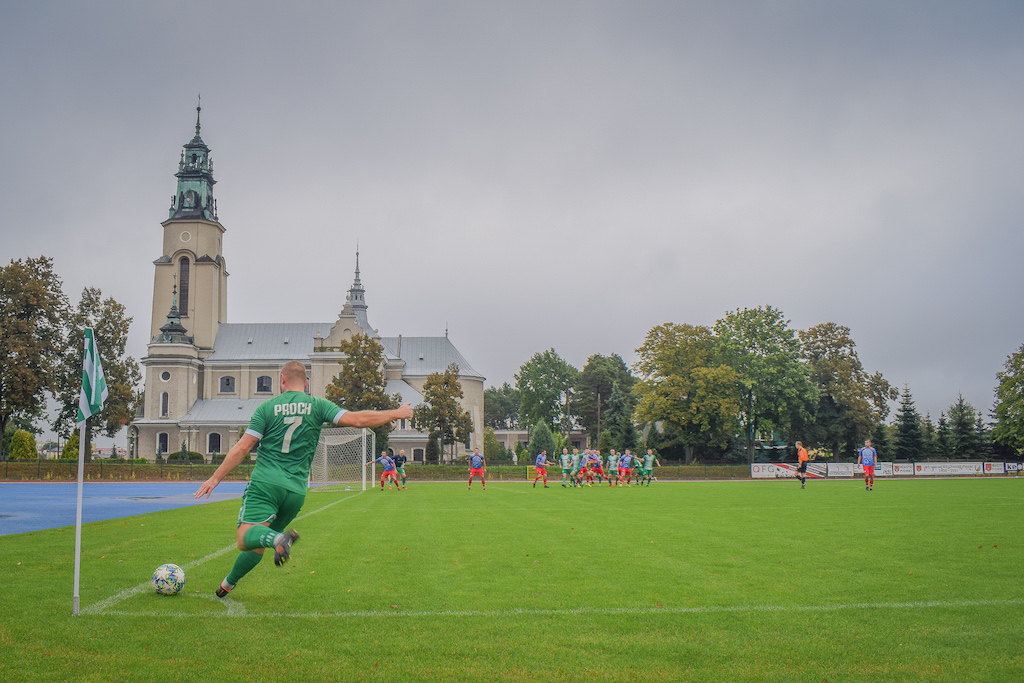
As a region though, Silesia can’t be beaten. It’s the heartland of Polish football, and as such it’s filled with battered old grounds to enjoy as well as several higher-profile clubs to complement the endless choice of minnows playing in beautifully shambolic curiosities. There is no standardised kick-off time in Poland like, say, 3 pm on Saturday, so with a bit of luck a weekend in Silesia has the potential to lead to a football overdose as you crash around the region chalking off match after match.
For a groundhopper mind, Czuwaj Przemysl in the south-eastern provincial leagues should be considered the ultimate grail. The ground looks like something from a fairy tale and the town is equally charming.

I’ve done 150 stadiums now in Poland, but there are still so many I want to see. I still feel I haven’t touched the sides and entire regions have been left unexplored. Time is running out – with so many grounds being replaced at all levels, I’m in the last chance saloon to tick off many crackers.
Many years ago I had an episode of hubris where I thought I had figured out Polish football. I’d done the top clubs, seen a few derbies, and been to a couple of ‘handy’ matches. I thought I had seen and done it all. I’m embarrassed now I even thought that in the first place. Every weekend reveals something new. I’m still no closer to seeing all that I want and ‘working it out’, so for the time being I’m not even looking beyond Poland’s borders.
The winter break is already in effect for the lower leagues, but the moment it’s over I’m heading to Polonia Slubice on the German border. It’s an epic pre-war ground that I’ve skipped because for years their ultra group had gone to ground. It’s been reactivated this season so I can’t wait to see a group of 50 hardcore shooting off flares in a vast historic ground.
Outside of Poland, I’m fascinated by the beauty and madness of Argentinean football – maybe I’ll trick my fiancée into going there on honeymoon when finally we get hitched!
